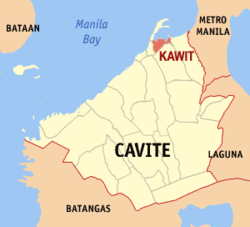Kawit, Cavite
| Kawit | ||
|---|---|---|
| Municipality | ||
 |
||
|
||
| Nickname(s): The Birthplace of Philippine Independence | ||
 Map of Cavite showing the location of Kawit |
||
| Location within the Philippines | ||
| Coordinates: 14°26′N 120°54′E / 14.43°N 120.9°ECoordinates: 14°26′N 120°54′E / 14.43°N 120.9°E | ||
| Country | Philippines | |
| Region | CALABARZON (Region IV-A) | |
| Province | Cavite | |
| Congr. district | 1st District of Cavite | |
| Founded | 1898 | |
| Barangays | 23 | |
| Government | ||
| • Mayor | Angelo Emilio G. Aguinaldo (NPC) | |
| • Vice Mayor | Armando Bernal (UNA) | |
| Area | ||
| • Total | 22.86 km2 (8.83 sq mi) | |
| Population (2015 census) | ||
| • Total | 83,466 | |
| • Density | 3,700/km2 (9,500/sq mi) | |
| Demonym(s) | Kawiteños | |
| Time zone | PST (UTC+8) | |
| ZIP code | 4104 | |
| IDD : area code | +63 (0)46 | |
| Website | kawitph |
|
Kawit (formerly Cavite El Viejo) is a first class urban municipality in the province of Cavite, Philippines. According to the 2015 census, it has a population of 83,466 people.
Kawit is the birthplace of Emilio Aguinaldo, the first President of the Philippines. It is also the location of his home, the Aguinaldo Shrine, where independence from Spain was declared on June 12, 1898. From 1895 to 1897, he served as the town's chief executive.
The name Kawit is derived from the Tagalog word kawit (hook) which is suggestive of its location at the base of a hookshaped shoreline along Manila Bay extending to the tip of Cavite City.
Legend, however, gives another version on how the town got its name. One day a Spanish visitor asked a native blacksmith about the name of the village. The latter was busy at the time pounding on the anvil a piece of hot metal that looked like a hook. He hesitated to speak, not understanding what the stranger was asking, but when pressed for an answer, and thinking that he wanted to know what he was doing, he merely said kawit (hook). The Spaniards left muttering the word kawit. In the course of the time the word kawit evolved into "cauite," and finally "cavite".
Kawit was the most thriving settlement prior to the coming of the Spaniards. In fact, the town provided the first anchorage of the Spaniards in the province, whence colonization and proselytization of the Christian religion began, spreading to all corners of the province.
For a long time, the place was called by the Spaniards "Cavite el Viejo" or Old Cavite to distinguish it from "Cavite la Punta" or "Cavite el Puerto," the commercial port and naval base (now Cavite City) whence came many Spanish marines on shore leave who made frequent visits to Cavite el Viejo, eventually turning it into a red light district. The bad reputation of the place, however, was completely wiped out when it was placed under the spiritual supervision of the Jesuits during the administration of Manila Archbishop Miguel Garcia Serrano (1618–1629) by placing St. Mary Magdalene as Patron saint of the town.
...
Wikipedia


